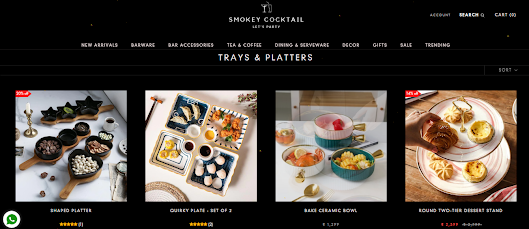What are the styles of ceramic platters?
Everyone gathers around a dining table to eat meals together in our household. Moreover, a significant part of the dinner table is the tableware. With them, we can eat lunch, supper, or morning.
The plates or cutlery mostly used for eating, serving, and setting the table is known as tableware. Every event has a different way of setting the table. Also, it is influenced by culture, food, the number of visitors, and religion. Smokey Cocktail offers each sort of dinnerware in the most elegant styles while staying within your price range.
There are four categories of tableware:
Serveware: Food products are served in serve ware. Serving bowls, platters, salad bowls, dessert bowls, casseroles, soup pots, and teapots are the important items used to help put food on the table. Serving spoons, ladles, and a set of tongs are other kitchenware items that fall into this category.
Dinnerware refers to dishes that include bowls and plates for use at meals. They vary in size, shape, and colour and are constructed of ceramic. See our assortment of dinnerware sets.
Silverware: Flatware is another name for silverware. These are the forks, spoons, and knives that the person uses. They can be of different sizes and shapes and are constructed of steel.
Drinkware is made of glass, such as cups, coffee mugs, and Ceramic platter online and is used for consuming wine or water. They are also offered in various sizes and forms depending on the situation.
Dishware is often made of wood, pewter, silver, gold, glass, plastic, and acrylic. Yet, in earlier times, tableware sets were usually composed of clay and pottery. Tiles, bricks, plates, and glasses are all made of non-metallic, solid ceramic.
Tableware produced specifically from ceramic materials is referred to as ceramic dishware. Typical examples of ceramics are pottery, terracotta, fine china, bone china, porcelain, glazed earthenware, paper clay, and stoneware. Cutlery, glasses, plates, bowls, mugs, vases, and all other culinary utensils used for cooking, serving meals, and setting the table make up the majority of tableware. The term "crockery" also applies to ceramic tableware.
Clay is burned at a high temperature to create ceramic. There are ceramics everywhere. In daily life, ceramic goods are utilised. They have a rigid, brittle character and are not compressible. Moreover, the ceramic platter is employed for roasting and baking. Because this equipment may be used for both dry and wet cooking, most people prefer ceramic cookware. They also don't attach to the food and keep it from burning. They are simple to clean after usage. Millions of years had passed before ceramic was discovered to be healthful and food-safe. It has been noted that ceramic's constituent parts are considered non-toxic.
Ceramic platter utensils are heat-resistant. Food can be prepared in an oven, microwave, or stove. It can be heated without cracking or melting, unlike plastic. This is so that heat is distributed evenly to the gas chambers by the product's ultimate material, porcelain, its main component. Yet, not all ceramics can withstand heat; only a few can. Be sure the specific utensil is heat-friendly before purchasing. Porcelain dinnerware is renowned for its toughness. When porcelain is burned at a very high temperature, it is solid and non-porous. While they appear frail, they are pretty sturdy. Next time, check to see if the ceramic dinnerware contains porcelain.




Comments
Post a Comment